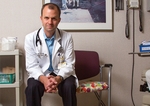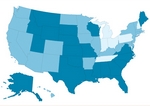Opinion
AMA campaigns for the uninsured
■ The AMA Voice for the Uninsured initiative has gone nationwide in its effort to encourage political candidates and voters to focus on the issue.
Posted Feb. 11, 2008.
- WITH THIS STORY:
- » Related content
Forty-seven million people in America don't have health insurance. The number is so big that it becomes abstract. It's too large to get your mind around. It's impersonal.
But behind the statistic are faces, people with life stories. Forty-seven million of them.
The personal level is where the national debate should focus. That's the message underlying the American Medical Association's Voice for the Uninsured campaign. The initiative, which just went national after being launched last fall in the early primary states, aims not only to put a face on the problem but also to encourage candidates to address the issue and citizens to vote with it in mind come the November elections.
The $15 million campaign features print, television, radio and Internet advertisements.
"One out of seven isn't just a statistic. It's a woman who chooses her blood pressure meds over her Parkinson's meds because she can't afford both," reads an AMA ad in U.S. News & World Report. The text accompanies a photo of a middle-age woman who really is uninsured. The ad goes on to say that although one in seven Americans lacks health coverage, "we all have access to a voting booth. Please vote with this issue in mind."
The campaign also includes podcasts featuring the music and stories of musicians who have gone without insurance. The AMA initiative will reach out to voters through healthy-lifestyle events and mobile billboards and will include profiles on the popular social networking sites MySpace and Facebook.
The Web site (link) dispels any preconceived notions about the uninsured as a group. It allows everyday people to describe their experiences being uninsured. Hundreds of people representing a cross section of America -- young and old, employed and unemployed, male and female, single and married -- have shared their stories. They are people we see each day.
The common themes running through the stories are that insurance simply is not affordable and that the inability to pay for it leaves people feeling afraid and powerless. An example: "If a sudden health problem does arise, I don't know how we will afford high medical bills. I just pray daily that we will stay healthy." This entry is from a married mother of three who does not have access to work-based insurance and whose family can't afford private coverage.
Physicians are familiar with the consequences of the problem. Uninsured patients delay needed care until their conditions escalate to the crisis point and are more difficult and costly to treat. Studies have shown that uninsured people live sicker and die younger.
The AMA's campaign isn't just about drawing attention to the situation. It's also about publicizing the solution. The Association has a health system reform plan and is sharing it with voters and political candidates.
The proposal not only would help the uninsured but also would improve the health system for everyone and aid doctors by reducing the need for charity care.
The plan has three main components: tax subsidies, consumer choice and insurance market reform. The first part calls for limiting the size of the federal income tax break for people with job-based insurance and using the resulting treasury savings to pay for subsidies, ideally tax credits, for low-income people. The size of the credit would depend on family income. It would be big enough to enable recipients to buy coverage, and the money would be available in advance of filing taxes.
The second component is individual choice of health insurance. The idea is that giving people the financial resources to buy insurance and instituting market reforms that spark insurance innovation would allow Americans to buy the coverage that best meets their needs.
The third part is to streamline insurance regulation nationwide and make it more uniform. The aim is to protect people with high medical risks from catastrophic costs while encouraging innovative and affordable coverage options.
The AMA's plan keeps its focus squarely where it belongs -- the 47 million uninsured people. The Association is asking voters and the candidates seeking their support to do the same.












